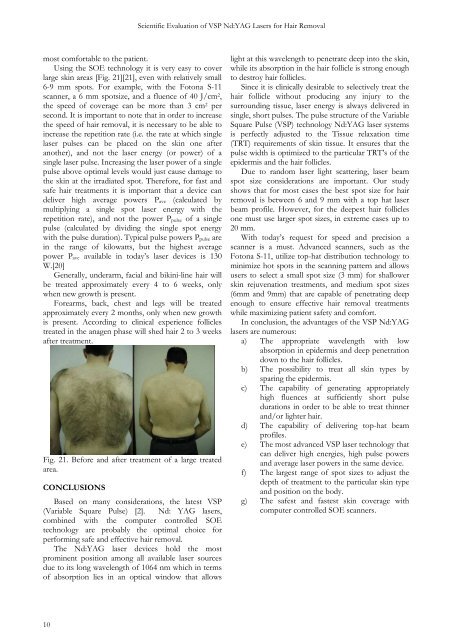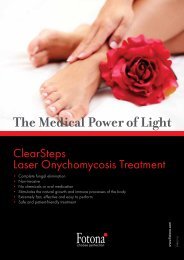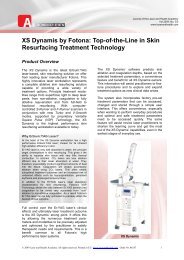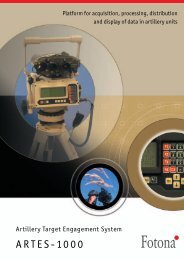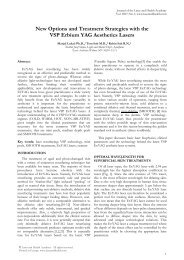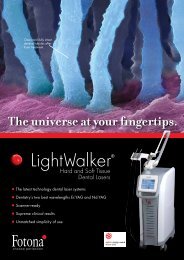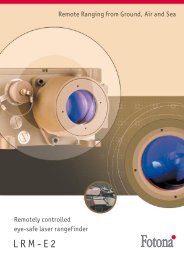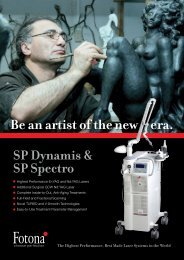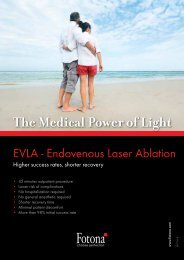Scientific Evaluation of VSP Nd:YAG Lasers for Hair Removal - Fotona
Scientific Evaluation of VSP Nd:YAG Lasers for Hair Removal - Fotona
Scientific Evaluation of VSP Nd:YAG Lasers for Hair Removal - Fotona
You also want an ePaper? Increase the reach of your titles
YUMPU automatically turns print PDFs into web optimized ePapers that Google loves.
<strong>Scientific</strong> <strong>Evaluation</strong> <strong>of</strong> <strong>VSP</strong> <strong>Nd</strong>:<strong>YAG</strong> <strong>Lasers</strong> <strong>for</strong> <strong>Hair</strong> <strong>Removal</strong><br />
most com<strong>for</strong>table to the patient.<br />
Using the SOE technology it is very easy to cover<br />
large skin areas [Fig. 21][21], even with relatively small<br />
6-9 mm spots. For example, with the <strong>Fotona</strong> S-11<br />
scanner, a 6 mm spotsize, and a fluence <strong>of</strong> 40 J/cm 2 ,<br />
the speed <strong>of</strong> coverage can be more than 3 cm 2 per<br />
second. It is important to note that in order to increase<br />
the speed <strong>of</strong> hair removal, it is necessary to be able to<br />
increase the repetition rate (i.e. the rate at which single<br />
laser pulses can be placed on the skin one after<br />
another), and not the laser energy (or power) <strong>of</strong> a<br />
single laser pulse. Increasing the laser power <strong>of</strong> a single<br />
pulse above optimal levels would just cause damage to<br />
the skin at the irradiated spot. There<strong>for</strong>e, <strong>for</strong> fast and<br />
safe hair treatments it is important that a device can<br />
deliver high average powers P ave (calculated by<br />
multiplying a single spot laser energy with the<br />
repetition rate), and not the power P pulse <strong>of</strong> a single<br />
pulse (calculated by dividing the single spot energy<br />
with the pulse duration). Typical pulse powers P pulse are<br />
in the range <strong>of</strong> kilowatts, but the highest average<br />
power P ave available in today’s laser devices is 130<br />
W.[20]<br />
Generally, underarm, facial and bikini-line hair will<br />
be treated approximately every 4 to 6 weeks, only<br />
when new growth is present.<br />
Forearms, back, chest and legs will be treated<br />
approximately every 2 months, only when new growth<br />
is present. According to clinical experience follicles<br />
treated in the anagen phase will shed hair 2 to 3 weeks<br />
after treatment.<br />
Fig. 21. Be<strong>for</strong>e and after treatment <strong>of</strong> a large treated<br />
area.<br />
CONCLUSIONS<br />
Based on many considerations, the latest <strong>VSP</strong><br />
(Variable Square Pulse) [2]. <strong>Nd</strong>: <strong>YAG</strong> lasers,<br />
combined with the computer controlled SOE<br />
technology are probably the optimal choice <strong>for</strong><br />
per<strong>for</strong>ming safe and effective hair removal.<br />
The <strong>Nd</strong>:<strong>YAG</strong> laser devices hold the most<br />
prominent position among all available laser sources<br />
due to its long wavelength <strong>of</strong> 1064 nm which in terms<br />
<strong>of</strong> absorption lies in an optical window that allows<br />
light at this wavelength to penetrate deep into the skin,<br />
while its absorption in the hair follicle is strong enough<br />
to destroy hair follicles.<br />
Since it is clinically desirable to selectively treat the<br />
hair follicle without producing any injury to the<br />
surrounding tissue, laser energy is always delivered in<br />
single, short pulses. The pulse structure <strong>of</strong> the Variable<br />
Square Pulse (<strong>VSP</strong>) technology <strong>Nd</strong>:<strong>YAG</strong> laser systems<br />
is perfectly adjusted to the Tissue relaxation time<br />
(TRT) requirements <strong>of</strong> skin tissue. It ensures that the<br />
pulse width is optimized to the particular TRT’s <strong>of</strong> the<br />
epidermis and the hair follicles.<br />
Due to random laser light scattering, laser beam<br />
spot size considerations are important. Our study<br />
shows that <strong>for</strong> most cases the best spot size <strong>for</strong> hair<br />
removal is between 6 and 9 mm with a top hat laser<br />
beam pr<strong>of</strong>ile. However, <strong>for</strong> the deepest hair follicles<br />
one must use larger spot sizes, in extreme cases up to<br />
20 mm.<br />
With today’s request <strong>for</strong> speed and precision a<br />
scanner is a must. Advanced scanners, such as the<br />
<strong>Fotona</strong> S-11, utilize top-hat distribution technology to<br />
minimize hot spots in the scanning pattern and allows<br />
users to select a small spot size (3 mm) <strong>for</strong> shallower<br />
skin rejuvenation treatments, and medium spot sizes<br />
(6mm and 9mm) that are capable <strong>of</strong> penetrating deep<br />
enough to ensure effective hair removal treatments<br />
while maximizing patient safety and com<strong>for</strong>t.<br />
In conclusion, the advantages <strong>of</strong> the <strong>VSP</strong> <strong>Nd</strong>:<strong>YAG</strong><br />
lasers are numerous:<br />
a) The appropriate wavelength with low<br />
absorption in epidermis and deep penetration<br />
down to the hair follicles.<br />
b) The possibility to treat all skin types by<br />
sparing the epidermis.<br />
c) The capability <strong>of</strong> generating appropriately<br />
high fluences at sufficiently short pulse<br />
durations in order to be able to treat thinner<br />
and/or lighter hair.<br />
d) The capability <strong>of</strong> delivering top-hat beam<br />
pr<strong>of</strong>iles.<br />
e) The most advanced <strong>VSP</strong> laser technology that<br />
can deliver high energies, high pulse powers<br />
and average laser powers in the same device.<br />
f) The largest range <strong>of</strong> spot sizes to adjust the<br />
depth <strong>of</strong> treatment to the particular skin type<br />
and position on the body.<br />
g) The safest and fastest skin coverage with<br />
computer controlled SOE scanners.<br />
10


